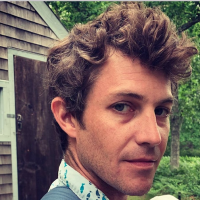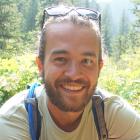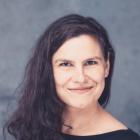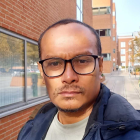I have an interest in this planet and if our Frankensteins blow it to smithereens, Uncle Samuel better be prepared to face a king-sized lawsuit.
This warning appeared in a letter to the Los Angeles Times published shortly after the “Flint-Worcester Tornado Outbreak Sequence.” On 8 and 9 June 1953, two of the deadliest tornadoes in US history destroyed their eponymous towns in Michigan and Massachusetts. Both towns were outside tornado alley. Survivors in Worcester initially thought the disaster was the work of an atomic bomb. A “goodly proportion” of its residents would continue to suspect it was the culprit, but not because they believed the destruction was the result of an enemy attack. It had been friendly fire—an atomic bomb test that took place on the other side of the continent a day before. In fact, nearly a third of the American public blamed the tornadoes on the bombs bursting in air somewhere in the Nevada desert.
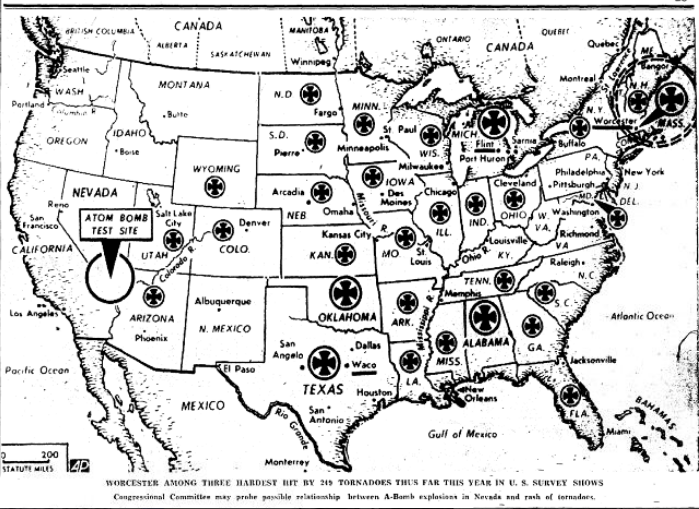
1953 Map depicting tornado strikes and their proximity to the Nevada testing grounds.
1953 Map depicting tornado strikes and their proximity to the Nevada testing grounds.
Originally published in the Worcester Evening Gazette, 11 June 1953.
Courtesy of Google Historical Newspapers.
Accessed on 11 July 2019. Click here to view source.
 This work is licensed under a Creative Commons Public Domain Mark 1.0 License.
This work is licensed under a Creative Commons Public Domain Mark 1.0 License.
The Worcester tornado was the most infamous case of a controversy in the 1950s over the potential effects of nuclear weapons testing on weather and climate—a menacing phenomenon people referred to most often as “atom weather.” Tens of thousands of letters from people convinced atomic testing was responsible for the extreme weather of the time flooded the offices of scientific experts at the Atomic Energy Commission (AEC), the United States Weather Bureau (USWB), and the World Meteorological Organization (WMO).
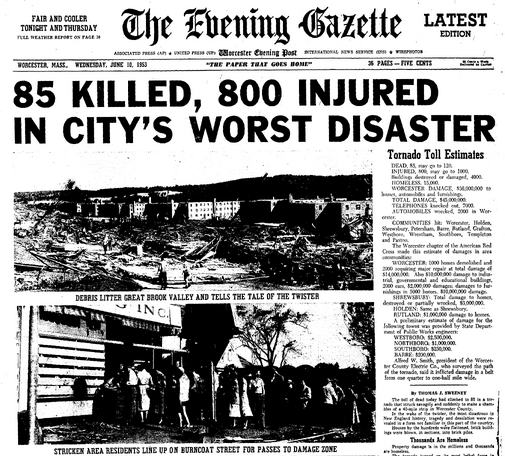
Front page of the Worcester Evening Gazette the day after the disaster.
Front page of the Worcester Evening Gazette the day after the disaster.
Worcester Evening Gazette, 10 June 1953.
Courtesy of Google Historical Newspapers.
 This work is licensed under a Creative Commons Public Domain Mark 1.0 License.
This work is licensed under a Creative Commons Public Domain Mark 1.0 License.
The ensuing uproar in the wake of the tornadoes made AEC experts duck for cover. Atom weather panic undermined public confidence in their assurance scientific experts could control any of the environmental risks from nuclear testing. Government meteorologists repeatedly denied the possibility, arguing the bomb was “puny” when held up against the awesome powers of nature. Dismayed with the invective hurled toward him and his colleagues, Lester Machta, head of the Special Projects Division of the USWB, quipped how curious it was that no one had yet blamed a nuclear explosion for a sunny day.
Many people did not find these types of quips amusing— they felt the AEC’s attitude toward the public was “deprecating,” “pontificating,” and “smart-alecky.” Growing demands that the AEC be held accountable for the disaster prompted a Massachusetts congressional representative, Edith Rogers, to file a resolution calling for a congressional inquiry. The House Committee on Armed Services held a hearing to consider Rogers’s motion on 23 June, in which statements from all the branches of the Armed Forces, the Federal Civil Defense Agency, and USWB unanimously agreed that there was no connection between the two. The committee denied the motion.

Photograph of Worcester in the aftermath of the tornado’s destruction.
Photograph of Worcester in the aftermath of the tornado’s destruction.
Originally published National Academy of Sciences National Research Council Committee on Disaster Studies, 1956. US Government report.
 This work is licensed under a Creative Commons Public Domain Mark 1.0 License.
This work is licensed under a Creative Commons Public Domain Mark 1.0 License.
The hearing did little to abate public fears. Further contributing to the summer’s atmospheric anxieties was the legal turmoil surrounding a burgeoning weather modification industry. Wildcat “rainmakers” promised desperate farmers they could alleviate the long western drought using the recently invented technology of cloud seeding, a technique used to induce artificial precipitation through the nucleation of clouds with silver iodide or dry ice. Spectacular claims by its publicity savvy co-inventor, the Nobel laureate chemist Irving Langmuir, primed the public to believe the practice was already altering the weather on a continental scale.
While there were analogical similarities between atom weather and cloud seeding, there were crucial differences. Cloud seeding at least promised potential benefits. The benefit of exploding bombs laced with deadly radiation was far murkier. More importantly, possession of atomic weapons was the exclusive purview of a “cult of Q-clearance” that enjoyed a complete monopoly on its research. This led farmers’ associations, such as the Cherry Growers of Beaumont, CA, to pool their resources and commission their own citizen science research, hoping to provide sufficient evidence to demand the AEC no longer detonate first and ask questions later.
The USWB’s meteorologists finally relented to public pressure and launched an in-depth research program in 1955. Most of their conclusions remained agnostic—the time frame of the bomb’s existence was too short to analyze its effects against long-term meteorological data. By the end of the decade, however, many of these scientists would admit that the possibility was not as far-fetched as they had previously imagined.
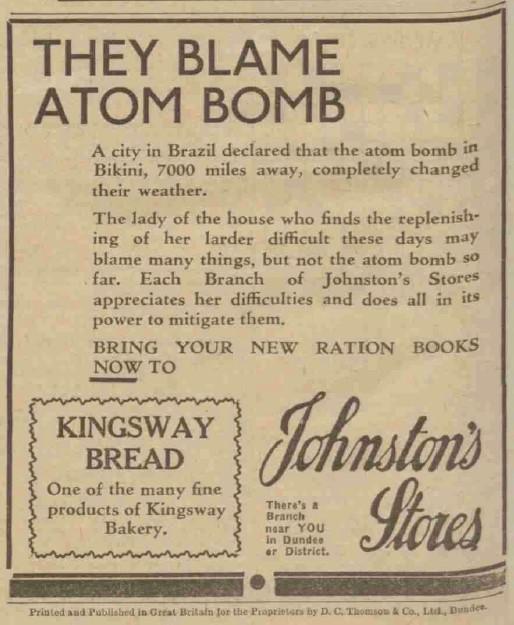
Ad for Kingsway Bread making light of complaints concerning “freak weather” during the first postwar nuclear test series in July of 1946, Operation Crossroads.
Ad for Kingsway Bread making light of complaints concerning “freak weather” during the first postwar nuclear test series in July of 1946, Operation Crossroads.
Dundee Evening Telegraph and Post, 12 July 1946.
 This work is licensed under a Creative Commons Public Domain Mark 1.0 License.
This work is licensed under a Creative Commons Public Domain Mark 1.0 License.
The farmers and their allies won the war of public opinion. A poll released in 1958 showed Japan, Brazil, and many European nations also believed atomic explosions were responsible for the “freak” weather of the time.But what was most important about atom weather was not verification of its existence. The atom weather controversy precipitated an early crisis concerning expert authority, democratic accountability, and who would have the right to determine the ecological health of the planet.
The record-breaking stretch of tornadoes that plagued the American Mid-West last spring, the question once more emerges concerning the attribution of human influence to the growing frequency and strength of these extreme weather events. Perhaps it is impossible to definitely determine a link with any individual weather event, but there is no uncertainty that anthropogenic climate disruption has fundamentally altered the planetary biosphere.
Atom weather was a metonym that marked the birth of this new epoch—the Anthropocene. Its union of the deep time legacy of radioactive toxicity with the global chaos of rapid climate change presaged a new age where human and natural disaster would become indistinguishable. Humanity would now have to grapple with its newfound planetary agency, one whose consequences threatened the future of the atmospheric commons, and with it, the future of life on earth.
How to cite
McBrien, Justin. “‘The Tornado Was Not the A-Bomb’s Child’:The Politics of Extreme Weather in the Age of Atmospheric Nuclear Weapons Testing.” Environment & Society Portal, Arcadia (Autumn 2019), no. 40. Rachel Carson Center for Environment and Society. doi.org/10.5282/rcc/8814.
ISSN 2199-3408
Environment & Society Portal, Arcadia
 This work is licensed under a Creative Commons Attribution 4.0 International License.
This work is licensed under a Creative Commons Attribution 4.0 International License.
2019 Justin McBrien
This refers only to the text and does not include any image rights.
Please click on the images to view their individual rights status.
- Dorries, Mathias. “The Politics of Atmospheric Sciences: “Nuclear Winter” and Global Climate Change.” Osiris 26, no. 1, Klima (2011): 198–223.
- Fleming, James Rodger. Fixing the Sky: The Checkered History of Weather and Climate Control. New York: Columbia University Press, 2010.
- Hamblin, Jacob. Arming Mother Nature: The Birth of Catastrophic Environmentalism. New York: Oxford University Press, 2013.
- Harper, Kristine. Make it Rain: State Control of the Atmosphere in Twentieth-Century America. Chicago: University of Chicago Press, 2017.
- Machta, L., and D. L. Harris. “Effects of Atomic Explosions on Weather.” Science 121, no. 3134 (1955): 75–81.
- Masco, Joseph. “Bad Weather: On Planetary Crisis.” Social Studies of Science 40 (2010): 7–40.
- Wallace, Anthony. Tornado in Worcester: An Exploratory Study of Individual and Community Behavior in an Extreme Situation. Washington, DC: National Academy of Sciences National Research Council, 1956.



